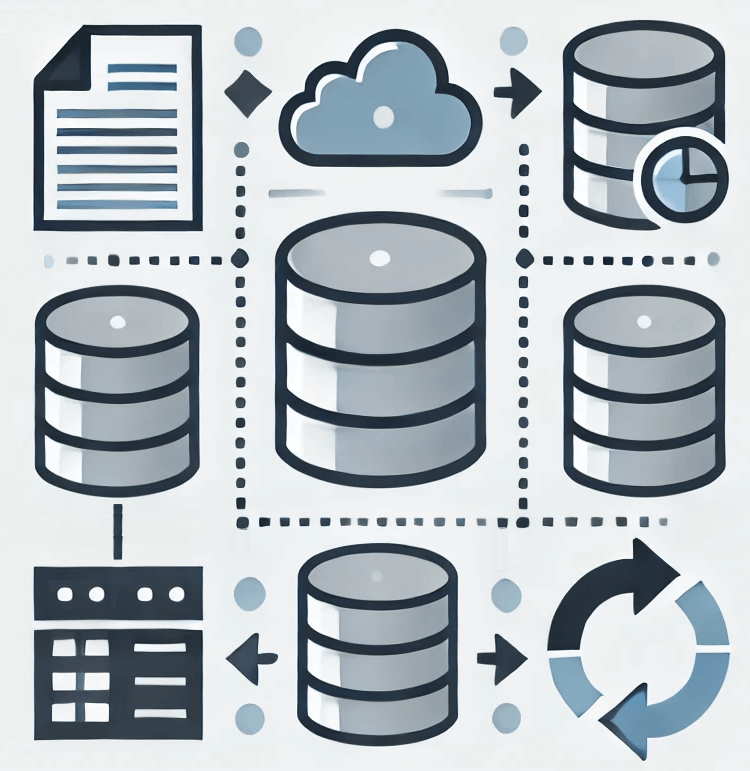Definition
Data management involves comprehensive processes designed to ensure the optimal collection, storage, and utilization of data within an organization. It encompasses the strategic alignment of technology, administrative policies, and organizational goals to facilitate effective data handling and decision-making. At the core, effective data management provides a framework for data storage, access, and processing, which aids in reducing inefficiencies and optimizing costs. By implementing robust data management systems, organizations can ensure data integrity, facilitate easy access for analysis, and maintain high standards of data security.
These systems are constructed to handle vast datasets across different storage platforms, enabling seamless data operations. This involves the strategic placement of data, sophisticated synchronization processes, and the deployment of advanced security protocols to protect data against unauthorized access and cyber threats. As data volumes grow and compliance requirements become more stringent, the role of data management becomes increasingly critical in ensuring that the organization’s data architecture can support both current and future needs.

Why is Data Management Important?
Effective data management is a cornerstone of modern enterprises, ensuring optimal use of storage resources and safeguarding critical information. Data management practices, such as data deduplication, compression, and tiered storage, significantly reduce storage costs and enhance system performance. By intelligently categorizing and storing data, organizations can ensure that frequently accessed information is available on high-performance storage systems while archiving less critical data on cost-effective solutions. This strategic allocation not only maximizes the performance and longevity of storage infrastructure but also supports scalability, allowing businesses to adapt to growing data demands without disproportionate investments in new hardware.
Beyond cost and efficiency, robust data management practices are vital for data integrity, availability, and security. Regular backups, redundancy protocols, and comprehensive disaster recovery plans prevent data loss and ensure business continuity in the face of hardware failures or cyber threats. Furthermore, strict data governance and access control measures protect sensitive information, maintaining compliance with regulatory standards and fostering trust with stakeholders. In an era where data breaches and downtime can have severe repercussions, investing in meticulous data management is indispensable for sustaining operational resilience and competitive advantage.
Here are some additional key benefits:
- Improved IT Efficiency: Streamlined processes reduce redundancies, boosting IT agility.
- Reduced TCO: Cost-effective data strategies lower overall expenses.
- Enhanced Data Security: Robust practices safeguard data and ensure regulatory compliance.
- Regulatory Compliance: Ensures adherence to laws, minimizing legal risks.
- Increased Data Accessibility: Enables faster access to data across the organization.
- Risk Mitigation: Reduces potential data-related risks and enhances business resilience.
Simplify Data Management with Software Defined Storage
Software-Defined Storage (SDS) enhances data management capabilities by providing a flexible and scalable framework that decouples the physical storage hardware from the data management layer. This separation allows for centralized management of data policies and facilitates easier integration with existing systems. SDS offers tools that automate data provisioning and optimize storage resources based on real-time demands, significantly simplifying the complexities of large-scale data environments.
SDS serves as a pivotal technology in modern data management strategies, facilitating seamless integration, management, and scalability across diverse storage environments. The upcoming sections delve deeper into specific data management practices enhanced by SDS capabilities.
Data Placement
Strategic data placement is critical to achieving high performance and cost-effectiveness in storage systems. It involves determining the optimal physical and logical location for data within the storage architecture, based on factors such as data access frequency, application requirements, and cost constraints. Effective data placement strategies ensure that frequently accessed data is readily available, while less frequently needed data is stored on more cost-effective, lower-performance media.
Advanced algorithms and machine learning models are often used to automate the data placement process, analyzing usage patterns and automatically adjusting the data location to optimize for performance and cost. This dynamic placement strategy not only improves overall system efficiency but also enhances user experience by reducing latency and speeding up data retrieval times.
Data Protection
 Data protection strategies are vital for safeguarding data against loss, corruption, and unauthorized access. Techniques such as RAID configurations, erasure coding, and advanced access controls are employed to protect data integrity and availability. Furthermore, regular backups and snapshots are scheduled to ensure data can be restored in its most recent state following data loss incidents. Encryption protocols are also implemented to secure data both at rest and in transit, thus protecting sensitive information against external breaches and insider threats.
Data protection strategies are vital for safeguarding data against loss, corruption, and unauthorized access. Techniques such as RAID configurations, erasure coding, and advanced access controls are employed to protect data integrity and availability. Furthermore, regular backups and snapshots are scheduled to ensure data can be restored in its most recent state following data loss incidents. Encryption protocols are also implemented to secure data both at rest and in transit, thus protecting sensitive information against external breaches and insider threats.
Incorporating immutability and Write Once Read Many (WORM) capabilities ensures that data cannot be altered once written, enhancing data integrity and compliance with regulatory requirements.
Data Resilience
Data resilience involves creating systems capable of recovering from hardware failures and cyber-attacks without data loss. Implementing redundant data architectures, such as multi-site replication or cloud storage mirroring, ensures that data remains available even if one part of the storage system fails. Continuous data protection and real-time replication techniques are crucial for environments requiring high availability and minimal downtime.
Building resilient systems often involves the use of technologies such as RAID (Redundant Array of Independent Disks), erasure coding, and geographically dispersed storage solutions. These technologies not only provide a safety net against potential data losses but also enhance the performance by distributing the workload across multiple nodes, thereby increasing the overall reliability and efficiency of data operations.
Data Recovery
Data recovery is a crucial component of data management, focusing on restoring data to its state before loss or corruption occurred. Effective data recovery strategies are characterized by quick, reliable recovery processes that minimize downtime and ensure continuity of operations. This involves not only traditional backup and restore techniques but also more sophisticated approaches like point-in-time snapshots and real-time data mirroring, which allow organizations to roll back to specific moments in time with minimal data loss.
Data recovery solutions are designed to respond rapidly to data loss incidents, enabling businesses to maintain operations with minimal interruption. Advanced data recovery strategies incorporate elements such as automated failover systems and the ability to recover data across distributed environments, which enhances the resilience and reliability of data infrastructure.
Data Archiving & Lifecycle Management
 Data archiving and lifecycle management deal with long-term data retention strategies that ensure data is kept securely and cost-effectively for future reference or regulatory compliance. Effective lifecycle management involves not only securing data but also ensuring it remains accessible when needed while optimizing storage costs. Policies and procedures are set based on the data’s value, legal compliance requirements, and how frequently it needs to be accessed.
Data archiving and lifecycle management deal with long-term data retention strategies that ensure data is kept securely and cost-effectively for future reference or regulatory compliance. Effective lifecycle management involves not only securing data but also ensuring it remains accessible when needed while optimizing storage costs. Policies and procedures are set based on the data’s value, legal compliance requirements, and how frequently it needs to be accessed.
Automated file tiering solutions help manage the transition of data from primary storage to more cost-effective archival storage systems. These solutions facilitate the retrieval and deletion processes, ensuring data is managed throughout its entire lifecycle—from creation to deletion—in compliance with organizational and regulatory standards.
Metadata Management
Metadata management is essential for organizing, finding, and managing data across large-scale storage infrastructures. It involves the creation, storage, and control of metadata, which provides contextual information about data assets, making it easier for organizations to manage their data effectively. Effective metadata management enables enhanced data discovery and governance, facilitating better data usage and compliance with internal and external regulations.
Metadata is particularly critical in object storage environments where data is stored not just as files but as objects that include metadata and data in a single unit. This allows for more efficient data retrieval and management, particularly in large, unstructured datasets.
Data Migration
Data migration is the process of moving data between storage types, formats, or systems, often necessitated by system upgrades, the adoption of new technologies, or shifts in strategic business needs. Effective data migration requires careful planning, execution, and validation to ensure data integrity is maintained throughout the process. This involves evaluating the source data, determining the most efficient transfer methods, and ensuring compatibility with the target system.
SDS facilitates migration between unlike devices, enabling easy decommissioning of old storage and upgrading or changing systems without the need for forklift upgrades, saving significant time and effort.
Data Deduplication and Compression
Data deduplication and compression are key techniques used to optimize storage efficiency and manage the exponential growth of data. Deduplication eliminates redundant copies of data, saving storage space and reducing the bandwidth required for data backups. Compression reduces the size of data files, allowing more data to be stored on the same physical hardware and improving the speed of data transmission across networks.
Compliance Assurance
Compliance assurance in data management involves meeting specific standards and regulations that dictate how data should be handled and protected. Effective data management practices help organizations meet these data-centric compliance requirements more effectively by providing robust mechanisms for data protection, data privacy, access control, and audit trails. This ensures that all data handling processes adhere to legal standards, protecting the organization from potential compliance violations and penalties.
How DataCore Can Help
DataCore offers a robust solution to the complexities of modern data management with its cutting-edge Software-Defined Storage technologies. By adopting DataCore, organizations can streamline their data operations, enhancing data accessibility, ensuring data integrity, and optimizing storage efficiency. DataCore simplifies the entire data lifecycle from placement to recovery, providing flexible and scalable solutions that adapt dynamically to changing data needs. This not only reduces operational overhead but also significantly lowers total cost of ownership (TCO).
Moreover, DataCore’s strong emphasis on security and compliance ensures that data is not only protected from breaches but also managed in accordance with regulatory requirements. Through advanced features like automated data provisioning, deduplication, and real-time replication, DataCore helps organizations maintain continuous operations and quick data recovery, supporting business continuity even under adverse conditions. With DataCore, companies gain a powerful ally in their quest to achieve efficient and secure data management, enabling them to focus more on strategic initiatives and less on data handling complexities.